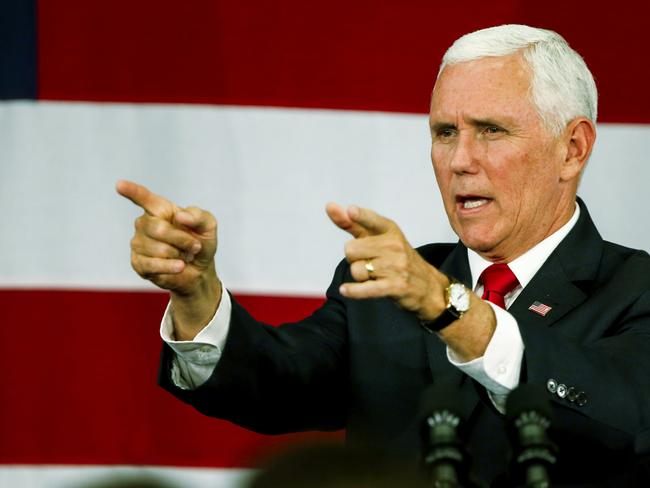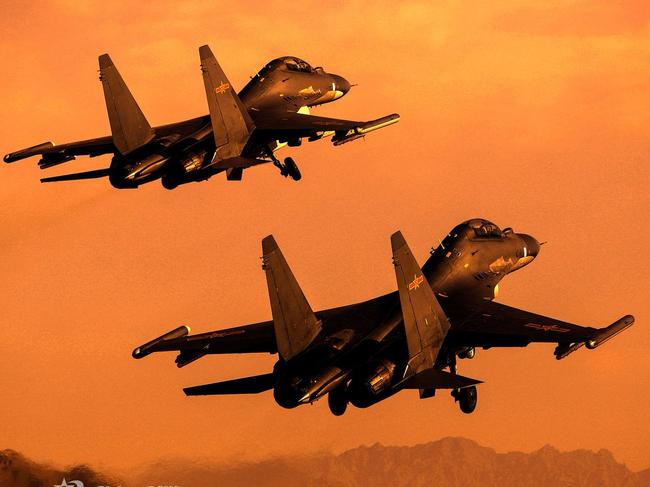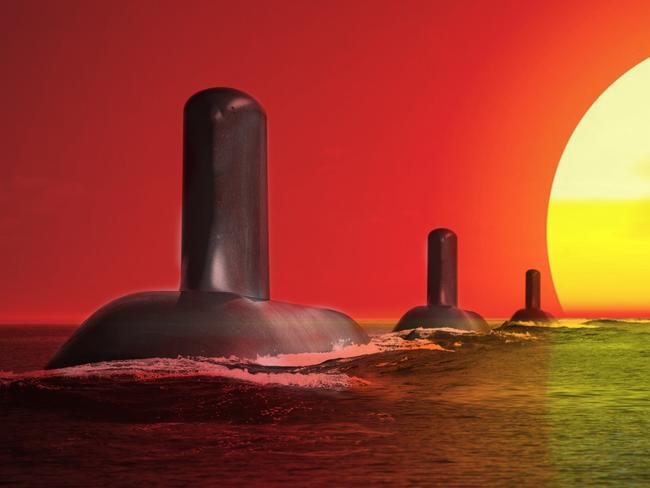AUSTRALIA’s new amphibious assault ships are up and running. The last of three new air warfare destroyers has been delivered. A fleet of new frigates and submarines are in the works. But is it enough? Is it the right stuff?
Honorary professor and former chief of the Australian Defence Force Chris Barrie fears it is not.
The world is “sleepwalking” into war, he warns.
Alarm bells included “a lack of strong and principled leadership, the problem of a rising power contesting other major powers for influence, the rise of nationalism, and the ineffectiveness of the UN Security Council in managing conflict situations.”
Writing in his capacity of honorary professor at the Strategic and Defence Studies Centre of Australian National University, Barrie says a provocative new speech by US Vice President Mike Pence has thrown down the gauntlet to China.
And that has serious consequences for Australia.
“It seems timely to look at Australia’s … readiness for the future if conflict does someday break out in our region,” Admiral Barrie says.
And, in doing so, he’s added his voice to a rising clamour from Australia’s international affairs and defence communities warning of dark times ahead.

“Our ability to play in the big game in our region and retain a military advantage if conflict does break out depends a lot on the capabilities of our opposing forces. And even here, an analysis of the current situation is not reassuring.”
It’s a matter of having the right stuff, at the right time, doing the right job.
“Will these plans deliver sufficient capability in time to meet significant strategic challenges?
“Will our shipbuilding enterprise be able to ramp up quickly to deliver more vessels if there is a sudden deterioration in our strategic circumstances?
“To what extent will we be able to build more vessels that are dependent on systems supplied from other countries?
“How dependent will these new capabilities be on the provision of spare parts and sophisticated weapons from overseas suppliers?”
Admiral Barrie does not have answers. Only questions.
“I raise them because I think we need to bear them in mind in today’s fast-moving strategic environment,” he says.
PENCE UPS THE ANTE
Earlier this month, US Vice-President Mike Pence took the rising tensions between his country and Beijing to a whole new level.
He bluntly accused China of interfering in US politics and using a “whole-of-government” approach to facilitate “the wholesale theft of American technology”.
“Using that stolen technology, the Chinese Communist Party is turning ploughshares into swords on a massive scale,” he warned.
Beijing was outraged.

China’s foreign ministry attacked Pence’s remarks as “malicious slander” and pulled out of “thin air.”
“No one can stop the Chinese people from steadfastly marching ahead along the path of Socialism with Chinese Characteristics and making greater achievements,” a foreign ministry spokesperson added.
RELATED: Beijing’s island-grabbing campaign gets close to home
Pence reiterated the determination of the White House to counter Beijing’s expansive ambitions.
But Admiral Barrie is not so confident the US will maintain its apex position in the regional balance of power.
“The US naval predominance will continue to erode in north Asia and give way to a multipolar balance. And in Southeast Asia, China will become predominant,” he writes.
“In addition, China may already be building a ‘post-American navy’ — one designed not to confront US naval predominance in the Pacific, but to inherit it as the US baulks at the increasing cost of continued regional leadership.”
The former admiral points to a recent ANU Strategic and Defence Study Centre paper by Senior Fellow Sam Roggeveen as a ‘must read’ by Australia’s policymakers and defence community.
It warns: “Australia must plan for a future in which its major ally is not the uncontested maritime leader in our region, and in which America’s will to maintain a pre-eminent place in the region will be severely tested.”
REGIONAL ARMS RACE
New submarines. New aircraft. New missiles. Most of South East Asia seems to have urgent and expensive shopping lists for weapons of war.
Their motivations are all similar.
China.
No aspect of its military has modernised and expanded faster than its navy.
And Beijing makes no secret of its intent.
It wants to be a great power.
It doesn’t want any nation to resist its global ‘belt-and-road’ and ‘second island chain’ agendas.
So it wants an overwhelming force, capable of projecting intimidating power to every corner of the Indian and Pacific Oceans.
And Australia’s vital, arterial shipping lanes flow through both.
According to US Naval War College professor Andrew S. Erikson, China is “poised to become the world’s second largest navy by 2020, and — if current trends continue — a combat fleet that in overall order of battle is quantitatively and even perhaps qualitatively on a par with that of the US Navy by 2030.”
RELATED: Can the US military continue to ‘contain’ China?
The ANU’s Roggeveen takes that warning to a disturbing conclusion.
“China already has the second most powerful navy in the Pacific and is developing the capability to match America’s maritime strength in the Pacific. America’s naval predominance will erode in North Asia and give way to a multipolar balance, but in Southeast Asia, Beijing will itself become predominant.”
FALLING TOWARDS APOTHEOSIS
“I have been watching developments in defence circles since the release of a series of white papers on defence in 2016,” Barrie writes.
While these have produced significant changes in how Australia is addressing its defence needs, he warns that — at least concerning our naval power — “we seem slow-moving and complacent in our decision-making and lack the agility to keep up with the times.”
While the Federal Government is sinking more money into modernising and expanding the fleet, The former admiral doubts this will produce an adequate fighting force to address the challenges of a rapidly changing region.
While the technology they carry had changed dramatically over the decades, Barrie warns their practical influence is little changed.
“I note, for example, that the new naval surface fleet will deliver about the same level of capability that Australia has had since I joined the Navy in 1961 — one surface task group of four ships. But in 1961, we also had the possibility of adding to the mix the power of a small aircraft carrier.”
RELATED: Does Australia’s new frigate have a fighting chance?
Australia’s modern Canberra-class LHD (Landing Helicopter Dock) ships may look like aircraft carriers, but are in fact poorly protected troop ships. They’re well equipped to support a beachhead of soldiers, but not the force that gets them there.
“To assess the adequacy of our current plans, we need to look ahead to what our region will look like in 2050,” Barrie warns. “Given these circumstances, will we have the assets to meet our needs if conflict does arise, or if there is a period of escalating tensions?”
THE ART OF WAR
The ANU paper by Roggeveen puts forward some considerations.
It points out China “has done more than any other military force to make large surface ships vulnerable”.
Essentially, it has built up a wall of heavily fortified artificial island bases capable of supporting ships, submarines and aircraft that launch swarms of long-range ship-killing missiles.
“Such is the capability of these systems that some observers now regard large surface ships as expensive follies or floating targets,” the ANU paper reads. “These weapons and carrying platforms are knitted together by a network of sensors—on submarines, surveillance aircraft, satellites, and in future a network of remote underwater sensors—designed to give China visibility of its maritime approaches and the ability to target hostile forces with great accuracy.”

It’s a tactic that has already put the contested South and East China Seas virtually out of the reach of US and allied forces. It also makes Taiwan increasingly vulnerable.
“Indeed, the risk to US maritime forces in the event of a US-China military clash over Taiwan is now so great that America’s implicit security guarantees to Taiwan are under severe strain. China’s A2/AD capabilities now make it doubtful that the United States could intervene in such a conflict at an acceptable cost.”
RELATED: China’s island fortresses exposed
However, area denial has proven so successful it could also be used against China’s influence.
“Australia should follow China’s example by focusing its maritime force structure on anti-access/area-denial (A2/AD) capabilities,” Roggeveen writes.
“Australia cannot pursue an A2/AD strategy without Indonesia’s consent, and preferably its co-operation. Our defence diplomacy should be concentrated on Jakarta.”
Admiral Barrie’s conclusion is cutting:
“We are not planning to do enough in this uncertain climate to assure Australians of a secure future in our region.”
FUTURE FORCE?
Australia is investing $50 billion in the design and construction of up to 12 new diesel-electric powered submarines. Another $35 billion is going towards the purchase of nine new general-purpose frigates.
Is this the right stuff?
“The plan to double the size of Australia’s submarine fleet is welcome, but given the leaps in Chinese capability, there are major questions around the pace of this program,” Roggeveen writes.
Australian Strategic Policy Institute (ASPI) analysts also have their doubts.
RELATED: Defence will soon be able to read the ‘fingerprints’ of your mind
In the face of China’s missile area-denial menace, submarines are the way to go, they say.
Surface ships have little time to react to modern supersonic missiles. And even shooting one down often does little more than turn the projectile into little more than an incoming shotgun blast.
Now, those missiles are rapidly becoming hypersonic.
This makes being underwater safer. This is why new submarines are featuring so heavily in the regional arms race.

But ASPI contributor and submarine specialist Peter Briggs says they must be nuclear powered to be effective, given Australia’s immense coastline and extended shipping lanes.
“It would be a protracted process requiring a lead time of 15 to 20 years, driven largely by the technical, training and educational preparations and a very significant increase in qualified personnel required to operate and maintain the force,” he admits.
“(But) a force of modern SSNs offers significant sea denial and force projection capabilities, providing at least twice the number of more capable submarines deployed at long range compared with an equivalent number of conventional submarines.”
RELATED: Cybernetics, biotech, microbes will soon joinAustrala’s arsenal
And on the subject of nuclear, ANU emeritus professor of strategic studies Paul Dibb has written an ASPI article which goes so far as to warn Australia’s deteriorating security outlook raises the prospect of needing our own nuclear weapons.
“We now have the prospect—for the first time since World War II—of a potential major-power adversary threatening us with high-intensity military conflict in our neighbourhood,” he writes.
“If, in extremis, we can no longer depend upon the US to defend us from threats from a nuclear-armed China, Australia might have to revisit the technological lead time we need to develop an independent nuclear weapon.”

Add your comment to this story
To join the conversation, please log in. Don't have an account? Register
Join the conversation, you are commenting as Logout
Here’s what you can expect with tomorrow’s Parramatta weather
As we move into winter what can locals expect tomorrow? We have the latest word from the Weather Bureau.
Who Owns Victoria’s farms: Biggest landholders revealed
Foreign and homegrown billionaires are gunning for a part of Victoria’s farmland. Who owns the biggest tracts of land? See the full list of 150-plus farms and their owners.